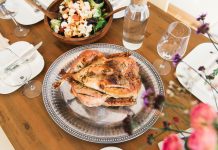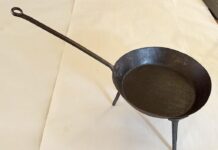Rhubarb offers the best of both the sweet and tangy worlds.
You may have childhood memories of going out into the garden with your grandma or grandpa, pulling the red stalks from the ground. Maybe you remember taking the rhubarb into the house to make rhubarb sauce or rhubarb pie.
Rhubarb isn’t just popular with your grandparents’ generation. Today, millennials are rediscovering the spring and summer treat that rhubarb brings to the table.
Planting rhubarb
Rhubarb is a vegetable that resembles celery, except its stalks are usually pink, pale red or cherry red in color. The stalks are topped by large green leaves.
Rhubarb is bought as crowns instead of seeds and can be planted either at the end of autumn when dormancy sets in or in early spring.
Fertile, well-drained soil works best for growing rhubarb, but it can be grown in other soils, too. Rhubarb should be planted at one side of the garden since it is a perennial. Allow about one square yard of space per rhubarb plant. Loosen soil to about 10 inches deep. Add 3 or 4 inches of compost or well-aged manure to the hole. Also toss in fertilizer that’s high in potassium and phosphorus, like 5-10-10.
Rhubarb growers should know that once it’s planted, it’ll produce for five years or even longer in some instances. It’s typically in-season during the spring and (early) summer.
Harvesting rhubarb
The first year that rhubarb is grown, it shouldn’t be harvested. The second year, only a few stalks should be harvested. From the third year on, rhubarb can be harvested in late May into June.
Rhubarb can be gently pulled from the ground or the stalk can be cut near ground level with a sharp knife. Be sure not to damage buds that are below the soil’s surface when harvesting rhubarb.
Rhubarb can be harvested until the stalks become slender, which indicates that the plant’s reserves are low. Only harvest a third to a half of a rhubarb plant’s stalks in order to sustain the crown.
Toxic leaves
The stalk of the rhubarb plant is edible, but it’s leaves are poisonous. They contained oxalic acid, which is toxic to humans. The leaves won’t harm other plants or organisms in the soil, though. They can be thrown away, placed on the compost pile or left in the garden as mulch.
Cooking rhubarb
Since rhubarb is very tart, use sugar to balance its flavor. Rhubarb is commonly paired with berries, apples, sugar, ginger, brown sugar, cinnamon, butter, cream, oranges or even sour cream.
Rhubarb is high in acid, so don’t use aluminum or cast iron pots and pans to cook it.
Nutritional value
Rhubarb is low in calories, high in acid and low in fiber. Its high calcium content isn’t easily absorbed due to the oxalic acid in the leaves and roots.
(1 cup diced rhubarb, uncooked)
Calories 26
Dietary Fiber 2 grams
Protein 1 gram
Carbohydrates 6 grams
Vitamin C 10 mg
Vitamin A 122 IU (international unit?)
Folic Acid 8.7 mcg
Calcium 105 mg
Potassium 351 mg
Rhubarb storage tips
Rhubarb will stay in the fridge for up to three days. Just put the stalks in plastic bags, then keep them in the crisper drawer of your refrigerator. To freeze, wrap rhubarb in tin foil first, then place in sealable plastic bags.
Sources: Ohio State University Extension, University of Illinois Extension

















